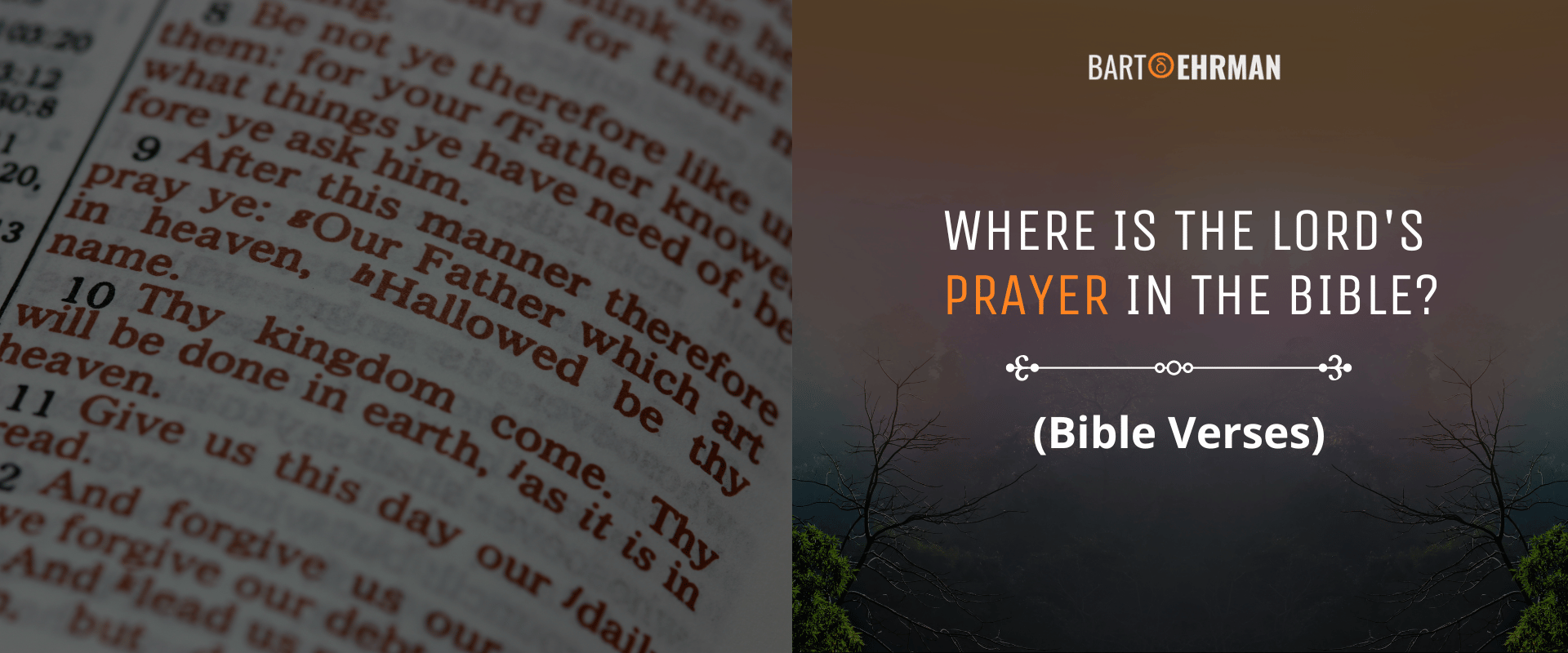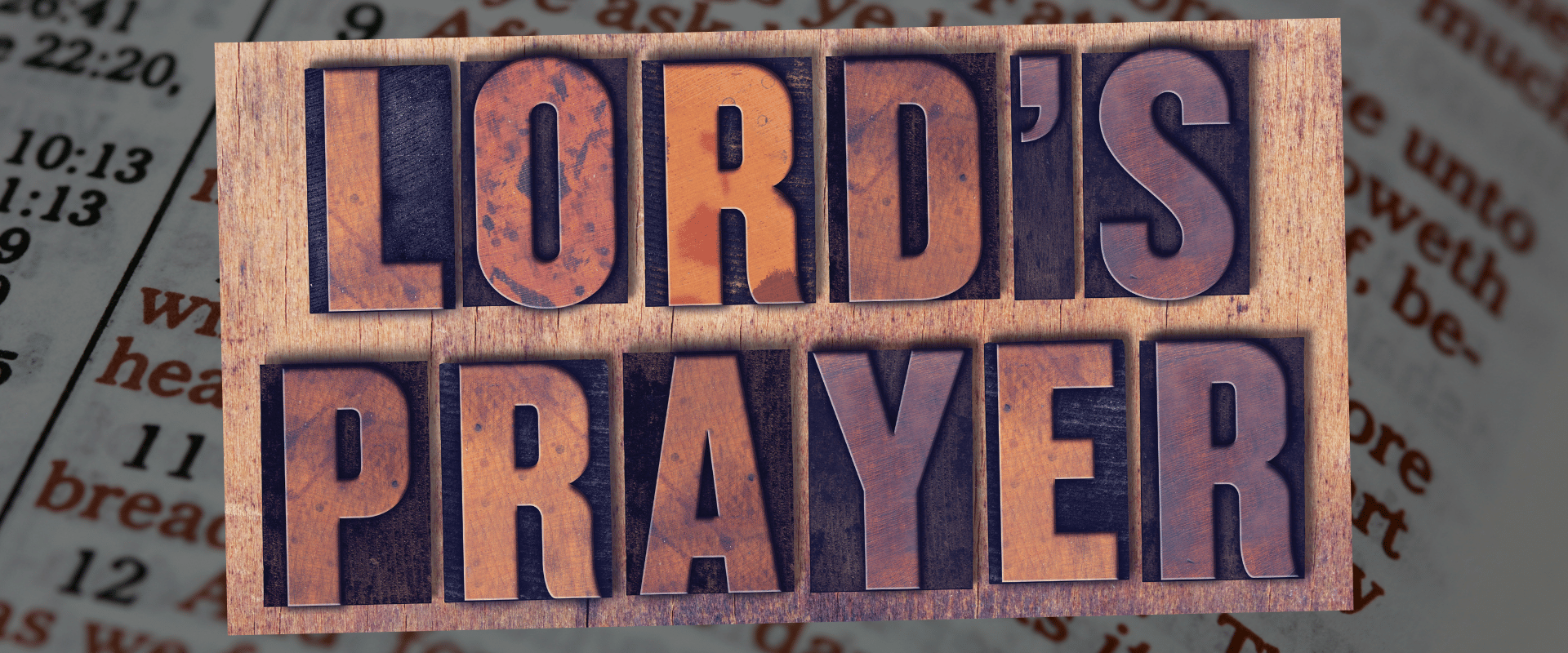Where is the Lord's Prayer in the Bible? (Bible Verses)

Written by Joshua Schachterle, Ph.D
Author | Professor | Scholar
Author | Professor | BE Contributor
Verified! See our editorial guidelines
Verified! See our guidelines
Edited by Laura Robinson, Ph.D.
Date written: October 19th, 2024
Disclaimer: The views and opinions expressed in this article belong to the author and do not necessarily match my own. - Dr. Bart D. Ehrman
The Lord’s Prayer is one of the most recited and cherished prayers in Christianity, a foundational element in the spiritual lives and liturgies of countless believers. This prayer includes core Christian beliefs about God, forgiveness, and daily sustenance. Where is the Lord’s Prayer in the Bible? Did you know there are two versions?
I’ll examine the two canonical versions of the Lord's Prayer, analyzing their contexts and variations. I’ll also explore the scholarly debate surrounding the prayer’s origins and explore its significance, its historical interpretations, and its enduring impact on Christianity.

Where Is the Lord's Prayer in the Bible?
There are two places in the Bible where we find it. The first place you can find the Lord’s Prayer verse is Matthew 6:9-13, and it is also in Luke 11:2-4. In English-speaking churches, the prayer is typically recited in its King James Version (KJV) form:
Our Father, who art in heaven,
hallowed be thy name;
thy kingdom come;
thy will be done;
on earth as it is in heaven.
Give us this day our daily bread.
And forgive us our trespasses,
as we forgive those who trespass
against us.
And lead us not into temptation;
but deliver us from evil.
For thine is the kingdom,
the power and the glory,
for ever and ever.
However, I’ll be analyzing both Matthew and Luke’s versions today in their New Revised Standard Updated Versions (NRSVUE) so that we have both the best-attested manuscripts of the prayers and the most recent scholarly translations:
Matthew 6:9-13 | Luke 11:2-4 |
|---|---|
Our Father in heaven, | Father, may your name be revered as holy. |
In both Matthew and Luke, Jesus teaches this form of prayer to his followers. In Matthew, it’s in the context of the Sermon on the Mount, a compilation of Jesus’ teachings placed by the author into one grand sermon. In Luke, however, Jesus himself is praying when an unnamed disciple approaches him and asks to be taught how to pray.
Notice some of the differences between the two versions. Obviously, Matthew’s version is longer, and although the two share many of the same ideas, their wording is slightly different. For example, Matthew’s version says “forgive us our debts (Greek: opheilēmata)” while Luke’s version says “forgive us our sins (Greek: hamartias).” Luke’s version lacks “May your will be done on earth as it is in heaven” as well as “but rescue us from the evil one.” How do we explain the differences between these two versions?
First, we have to address the Synoptic Problem, the scholarly insight that while our earliest Gospel Mark was used as a source by both Matthew and Luke, those two later Gospels also share material that is not in Mark. This has long prompted scholars to postulate another source they call Q (from the German word Quelle meaning “source”). For those who believe in Q’s existence, the Lord’s Prayer comes from this Q source. This brings up a question, though: which version is closest to the original from Q?
In his book The Lord’s Prayer, C. Clifton Black says that Luke’s version is likely most similar to the original. On what basis does he make this determination? He writes that “scribes who transmitted biblical texts tended to expand the material they were copying rather than contract it.” In other words, if a passage was short and difficult to understand, scribes often added explanatory material to it. (Affiliate Disclaimer: We may earn commissions on products you purchase through this page at no additional cost to you. Thank you for supporting our site!)
This would explain, for example, why the author of Matthew added “but rescue us from the evil one” to the shorter line “do not bring us to the time of trial.” This line alone seems to imply that God leads us into trials, so adding that he can rescue us as well would be more comforting. Notice also that Matthew’s longer version has, for centuries, completely supplanted Luke’s short version in church usage, which might indicate that, over time, people found it easier to understand and accept.
Interestingly, the Didache, an early Christian text which was ultimately excluded from the biblical canon, essentially contains Matthew’s version but adds a line at the end: “For yours is the power and the glory forever.” Neither the Catholic Church nor the Orthodox Church use this line — called the “Minor Doxology” — in their recitations of the prayer. Protestants use it, however, adding “thine is the kingdom” as well.
The Lord’s Prayer in Jewish Tradition?
The Lord’s Prayer remains foundational to all current forms of Christianity. However, is there anything specifically Christian in the prayer (besides its attribution to Jesus)? In fact, there is nothing in its contents — no naming of Jesus as the Messiah or references to his death or resurrection — that could not comfortably exist as Jewish prayer. Let’s look at some of those ideas as found in Jewish sources.
God is called “Father” in numerous Hebrew Bible texts. Isaiah 63:15-16, for example, says "Look down from heaven and see, from your holy and beautiful habitation... for you are our Father," while Deuteronomy 32:6 asks “Is not [God] your father who created you?”
Likewise, many of the ideas in the Lord’s Prayer can be found in a Jewish prayer called the Kaddish, (Aramaic for “holy”), parts of which go back to the 1st century BCE. For example, the Kaddish begins by saying “Glorified and sanctified be God’s great name throughout the world which He has created according to His will.” The notion of glorifying God’s name and the emphasis on God’s will are as evident here, as they are in the Lord’s Prayer. The Kaddish also says “May He establish His kingdom in your lifetime and during your days,” analogous to “May your Kingdom come.”
Some of the ideas in the Lord’s Prayer are also found in another Jewish prayer called the Amidah, which, according to David Instone-Brewer, can be traced to the Second Temple period of Jewish history (516 BCE-70 CE). One line in this prayer says “Pardon us, our Father, for we have sinned; forgive us, our King, for we have transgressed.” Additionally, while the Lord’s Prayer says “Give us each day our daily bread,” the Amidah says “Satisfy us from Your bounty.”
Finally, from the Mourner’s Kaddish Prayer, we see “Lead us not into sin and transgression, iniquity, temptation and disgrace, so that evil will not rule over us.” This is clearly comparable to “Lead us not into temptation but deliver us from evil.”
My point is not that the Lord’s Prayer doesn’t fit with Christianity, but rather that it fits equally well with, and is clearly based upon, Jewish prayers, many of which are still prayed today in synagogues.
Now that we’ve seen the Jewishness of the Lord’s Prayer, let’s look more closely at interpretations of it throughout Christian history.
FREE COURSE!
WHY I AM NOT A CHRISTIAN
Raw, honest, and enlightening. Bart's story of why he deconverted from the Christian faith.
Over 6,000 enrolled!
Interpretations of the Lord’s Prayer
Some of the most prominent Christian authors have interpreted the Lord’s Prayer for centuries. Here, I’ll take a look at how the prayer and its significance have been understood through various authors in different eras of Christianity.
Tertullian (160-240 CE), the earliest Latin Christian theologian, wrote a detailed commentary on the Lord’s Prayer, noting that it contained “not only the special duties of prayer, be it veneration of God or petition for man, but almost every discourse of the Lord, every record of His Discipline; so that, in fact, in the Prayer is comprised of an epitome of the whole Gospel.” Tertullian also exhaustively explained how every line in the prayer, in his opinion, lined up perfectly with Scriptures from the Old and New Testaments.
One of the most significant theologians and authors in Christian history was Augustine of Hippo (354-430 CE). In a letter, Augustine broke down each line of the prayer. For Augustine, the true import of the prayer was that it helped Christians to ask for what they should rather than merely trying to convince God to satisfy all their desires:
We need to use words so that we may remind ourselves to consider carefully what we are asking, not so that we may think we can instruct the Lord or prevail on him… Whatever be the other words we may prefer to say… we say nothing that is not contained in the Lord’s Prayer, provided of course we are praying in a correct and proper way.
Protestant cleric and theologian John Wesley (1703-1791) wrote his own line-by-line commentary as well. In the preface to this commentary, Wesley wrote:
He who best knew what we ought to pray for, and how we ought to pray, what manner of desire, what manner of address would most please himself, would best become us, has here dictated to us a most perfect and universal form of prayer, comprehending all our real wants, expressing all our lawful desires; a complete directory and full exercise of all our devotions.
What is interesting about Wesley’s take is that he believes that Jesus taught this particular prayer to future Christians because Jesus — whom Christians believed was God — was teaching them the way he himself wanted to be addressed, in effect saying “This is how you should pray to me.” This notion is not in the original biblical text at all, but is an 18th century Protestant interpretation.
We get a different take from the modern Catholic Church. In 2017, Pope Francis spoke about the Lord’s Prayer, specifically addressing what he saw as a translation issue that could create a theological issue for Catholics.
In a new television interview, Pope Francis said the common rendering of one line in the prayer —“lead us not into temptation”— was “not a good translation” from ancient texts. “Do not let us fall into temptation,” he suggested, might be better because God does not lead people into temptation; Satan does.
While this certainly fits Catholic theology, the Pope was incorrect about the proper translation. Bart Ehrman notes that the Greek translation of the phrase “Lead us not into temptation” “does not talk about Satan leading people into temptation or about people ‘falling’ into temptation.” Instead, he says
The proper translation… is “Do not bring us into temptation.” It’s not ambiguous. It is directed to “Our Father” and it is asking God not to put a person into a time of temptation or trial. The word “temptation” can mean what we mean by it – the temptation to do something wrong or sinful. But it can also refer to a test or trial. So it could mean something like: don’t make us undergo a time of trial at the end of this age.
While it may be uncomfortable for Christians to conceive of God placing people in positions where they are tempted, this is what the original Greek says in both Matthew and Luke’s versions.

Conclusion
The Lord’s Prayer is foundational to Christian practice. Every denomination practices some form of it. Where is the Lord’s Prayer in the Bible? You’ll find it in Matthew and Luke, and both Gospels say it was taught directly by Jesus, which reinforces its significance.
While those two Gospels each have versions which share basic ideas, most textual critics agree that Luke’s shorter version is closest to the original. Ancient scribes added explanatory material to short, difficult passages far more often than they subtracted material. Given this, it would seem that the author of Matthew probably took the shorter original and added extra lines for clarification. Ironically, this is the version used in churches today.
While the importance of the Lord’s Prayer for Christianity is undeniable, what is equally evident is that all of its ideas can be found in Jewish prayers as well. The prayer itself contains no direct references to Jesus as Messiah or to his death and resurrection. Instead, it takes common ideas from the Hebrew Bible and well-known Jewish prayers, such as the Amidah and the Kaddish.
A key sign of the prayer’s enduring significance is that many Christian authors have commented on it throughout the centuries, adding their own interpretations and acknowledging the continuing importance of the prayer for Christians.
FREE COURSE!
WHY I AM NOT A CHRISTIAN
Raw, honest, and enlightening. Bart's story of why he deconverted from the Christian faith.
Over 6,000 enrolled!
